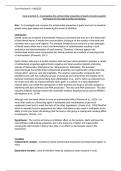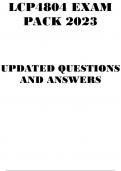Exam (elaborations)
CP9 write up - Investigate the antimicrobial properties of plants
- Module
- Core Practicals
- Institution
- PEARSON (PEARSON)
Edexcel A Biology A level core practical Write ups. All include an introduction, hypothesis, variables, method, results, evaluations... CP9 - Investigate the antimicrobial properties of plants, including aseptic techniques for the safe handling of bacteria
[Show more]




